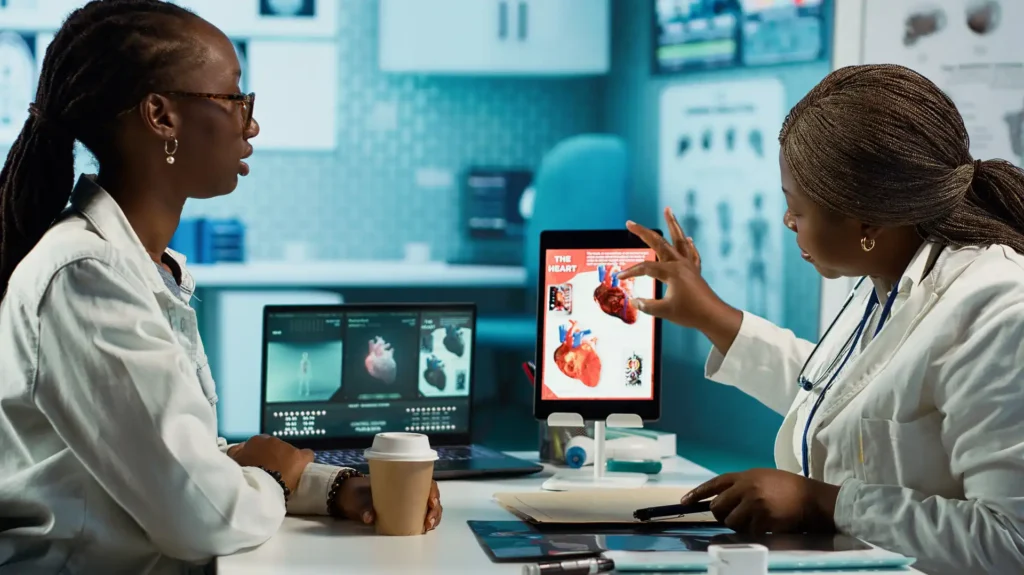
Telehealth Expansion Transforms Nursing Practice with 25% of Nurses in Remote Care Roles
2025
The rapid expansion of telehealth services has fundamentally transformed nursing practice, with approximately 25% of nurses now spending significant portions of their time in telehealth roles, representing one of the most significant shifts in healthcare delivery since the COVID-19 pandemic.
Build the future you deserve. Get started with our top-tier Online courses: ACCA, HESI A2, ATI TEAS 7, HESI EXIT, NCLEX-RN, NCLEX-PN, and Financial Literacy. Let Serrari Ed guide your path to success. Enroll today.
Telehealth Evolution and Growth

What began as an emergency response to pandemic restrictions has evolved into a fundamental component of modern healthcare delivery, with nurses playing increasingly central roles in virtual care coordination and patient management.
Current Telehealth Statistics:
- 25% of nurses engaged in significant telehealth activities
- Sustained growth beyond pandemic emergency measures
- Integration across all healthcare settings and specialties
- Technology advancement driving expanded capabilities
Nursing Roles in Telehealth Delivery
Virtual Care Coordination:
- Remote patient monitoring and assessment
- Care plan development and modification
- Medication management and adherence support
- Health education and patient counseling
Chronic Disease Management:
- Diabetes care and monitoring programs
- Hypertension and cardiovascular care
- Mental health and behavioral support
- Post-acute care and transitional care
Preventive Care Services:
- Health screening and risk assessment
- Vaccination and immunization coordination
- Wellness coaching and lifestyle modification
- Health promotion and disease prevention
Technology Integration and Capabilities
Advanced Monitoring Systems:
- Wearable device integration and data analysis
- Remote vital sign monitoring and trending
- Artificial intelligence-supported assessment
- Predictive analytics for early intervention
Communication Platforms:
- Video conferencing and virtual consultation
- Secure messaging and patient portal integration
- Mobile health applications and tools
- Electronic health record integration
Decision Support Tools:
- Clinical guidelines and protocol access
- Drug interaction and allergy checking
- Evidence-based practice recommendations
- Quality improvement and outcome tracking
Benefits for Nursing Practice
Professional Flexibility:
- Work-from-home and remote practice opportunities
- Flexible scheduling and improved work-life balance
- Reduced commuting and travel requirements
- Geographic independence and mobility
Clinical Effectiveness:
- Enhanced patient access and care continuity
- Improved chronic disease management outcomes
- Reduced emergency department visits and hospitalizations
- Cost-effective care delivery and resource utilization
Professional Development:
- Technology skills advancement and innovation
- Specialization in virtual care delivery
- Leadership opportunities in digital health
- Research and quality improvement participation
Ready to level up your career? Join our expert-led Online courses in ACCA, HESI A2, ATI TEAS 7, HESI EXIT, NCLEX-RN, NCLEX-PN, and Financial Literacy. At Serrari Ed, we turn potential into achievement. Start your journey today!
Patient Care Enhancement
Improved Access:
- Rural and underserved population reach
- Elimination of transportation barriers
- Convenient appointment scheduling and availability
- Immediate access to nursing expertise and support
Quality and Safety:
- Consistent monitoring and follow-up care
- Early identification of complications and concerns
- Medication adherence and safety monitoring
- Evidence-based care delivery and documentation
Patient Satisfaction:
- Convenience and comfort of home-based care
- Enhanced communication and engagement
- Personalized care delivery and attention
- Family involvement and support facilitation
Implementation Challenges and Solutions
Technology Barriers:
- Digital literacy and access limitations
- Internet connectivity and equipment requirements
- Privacy and security concerns
- Integration with existing systems and workflows
Regulatory and Policy Issues:
- Licensure and practice across state lines
- Reimbursement and payment policy variations
- Professional liability and malpractice considerations
- Quality assurance and accountability standards
Clinical Practice Adaptation:
- Virtual assessment and examination techniques
- Communication skills for remote interactions
- Documentation and record-keeping modifications
- Emergency response and crisis management protocols
Training and Professional Development
Core Competencies:
- Virtual communication and interpersonal skills
- Technology proficiency and troubleshooting
- Remote assessment and clinical judgment
- Cultural competency for diverse populations
Certification and Credentialing:
- Telehealth nursing certification programs
- Continuing education and professional development
- Quality assurance and competency validation
- Professional recognition and advancement
Educational Integration:
- Nursing school curriculum updates and enhancements
- Clinical rotation and experience opportunities
- Simulation and virtual learning environments
- Faculty development and training programs
Future Directions and Innovation
Emerging Technologies:
- Artificial intelligence and machine learning integration
- Virtual reality and augmented reality applications
- Internet of Things (IoT) device connectivity
- Blockchain technology for secure data sharing
Care Model Evolution:
- Hybrid virtual and in-person care delivery
- Team-based care coordination and collaboration
- Population health management and outcomes
- Value-based care and payment models
Policy and Regulatory Development:
- Interstate nursing licensure compacts
- Telehealth reimbursement and coverage expansion
- Quality standards and outcome measurement
- Professional practice guidelines and protocols
Research and Evidence Development
Outcome Studies:
- Patient satisfaction and quality of care metrics
- Clinical effectiveness and safety outcomes
- Cost-effectiveness and resource utilization
- Nursing satisfaction and retention rates
Innovation and Best Practices:
- Technology optimization and workflow efficiency
- Care delivery model effectiveness
- Training and education program evaluation
- Quality improvement and patient safety enhancement
The transformation of nursing practice through telehealth expansion represents a permanent shift in healthcare delivery, requiring continued investment in technology, training, and policy development to maximize benefits for patients, nurses, and healthcare systems. This evolution impacts registered nurses, nurse practitioners, healthcare professionals, and creates new opportunities in nursing jobs, remote nursing, and virtual healthcare across the healthcare industry.
Source: Alliant University – Top 9 Nursing Trends 2025
Ready to take your career to the next level? Join our Online courses: ACCA, HESI A2, ATI TEAS 7 , HESI EXIT , NCLEX – RN and NCLEX – PN, Financial Literacy!🌟 Dive into a world of opportunities and empower yourself for success. Explore more at Serrari Ed and start your exciting journey today! ✨
Track GDP, Inflation and Central Bank rates for top African markets with Serrari’s comparator tool.
See today’s Treasury bonds and Money market funds movement across financial service providers in Kenya, using Serrari’s comparator tools.
